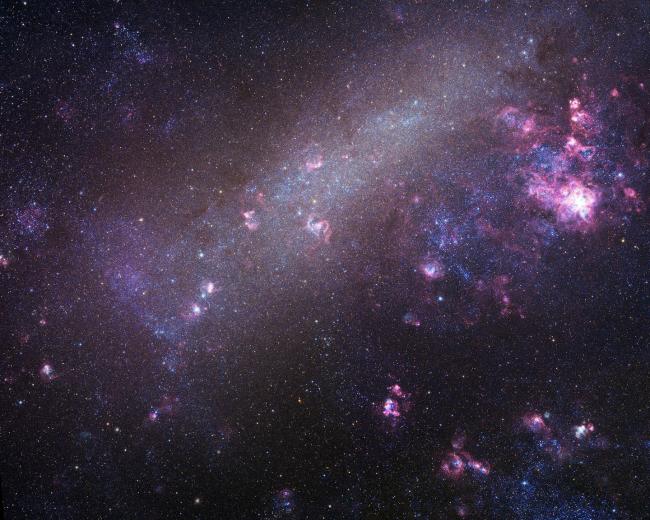
Astronomers have measured the 3-D velocities of the Large Magellanic Cloud (shown here) and the Small Magellanic Cloud. They found surprisingly high speeds, which may indicate that the Milky Way is twice as massive as previously thought, or that the Magellanic Clouds are not gravitationally bound to the Milky Way but instead are "just passing through."
The two most prominent, nearby galaxies to our Milky Way are the Large Magellanic Cloud (LMC) and the Small Magellanic Cloud (SMC). They lie about 160,000 light-years away, in the outskirts of our galaxy; each is readily visible to people in the southern hemisphere. Named for the European explorer Ferdinand Magellan, these galaxies are relatively modest in their properties: the LMC has an estimated mass less than about ten percent of the Milky Way's mass, while the SMC is about ten times smaller still. Although small in size, however, their influence on the Milky Way is considerable. It is thought that interactions between the Magellanic Clouds and our galaxy have played an important part in determining the present shape of the Milky Way and in the evolution of its stars, especially in its outer regions. The Magellanic Clouds are difficult to study, however, because they are spread across a large swath of sky - about sixteen times bigger than the full Moon in angular size -- and their stars are faint.
It turns out that the LMC and the SMC are moving at relatively high velocities. It has been known for many years from spectral analyses that they have a component of motion towards the Milky Way, but it has been much more difficult to measure their motions across the plane of the sky. SAO astronomer Charles Alcock and his student, Nitya Kallivayalil, along with a colleague, have used the Hubble Space Telescope to compare the positions of stars in the SMC and LMC with the positions of fixed, distant quasars, and so to obtain the net three-dimensional velocities of the Clouds. Writing in last month's Astrophysical Journal, the team reports their precise new results: the galaxies are moving surprisingly fast -- the LMC at 387 kilometers/second, and the SMC at 302 kilometers/second.
The astronomers calculate two likely, possible reasons for these rapid motions consistent with their measurements. The first is that the total mass of our own galaxy is larger than has been thought; indeed, the Milky Way's mass has probably increased over time as it gains material from these neighbors. The second is that the Milky Way's mass is not larger than currently thought, but that the Magellanic Clouds are then not bound by gravity to our own galaxy; they are just passing though, and in another billion years they will escape from our vicinity. Either way, our understanding of our galactic neighborhood has to be dramatically revised.